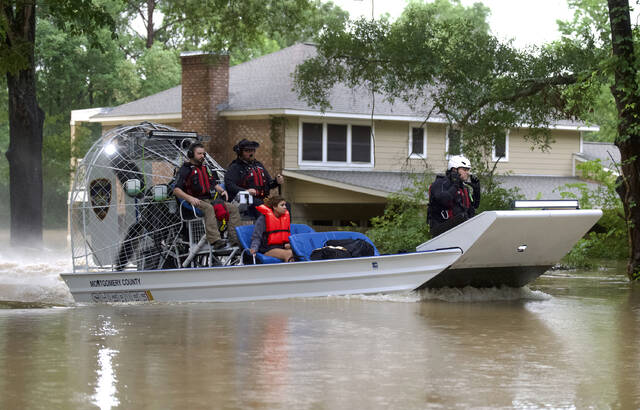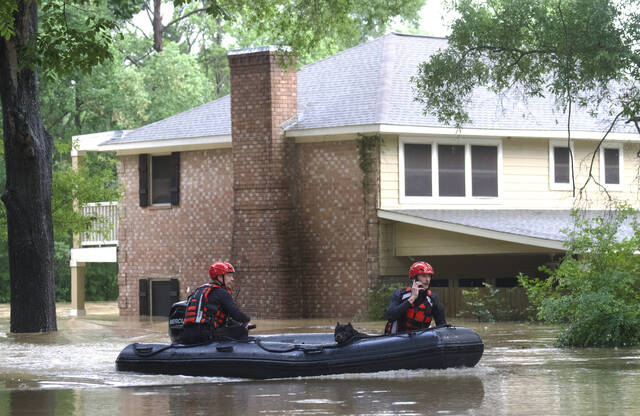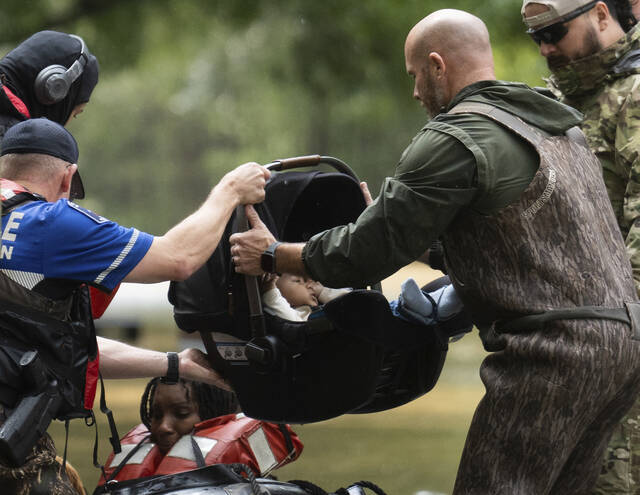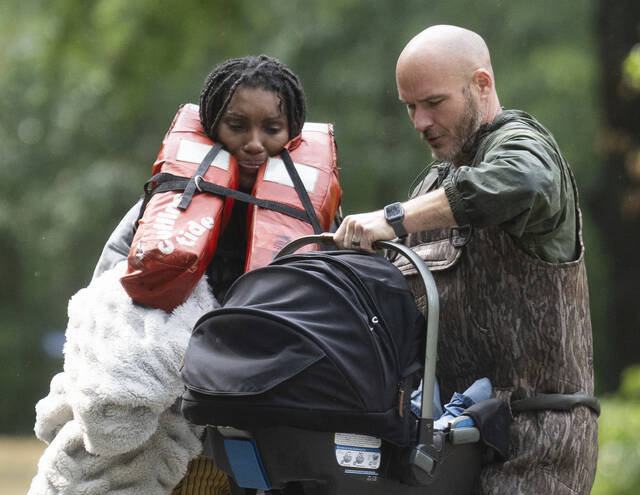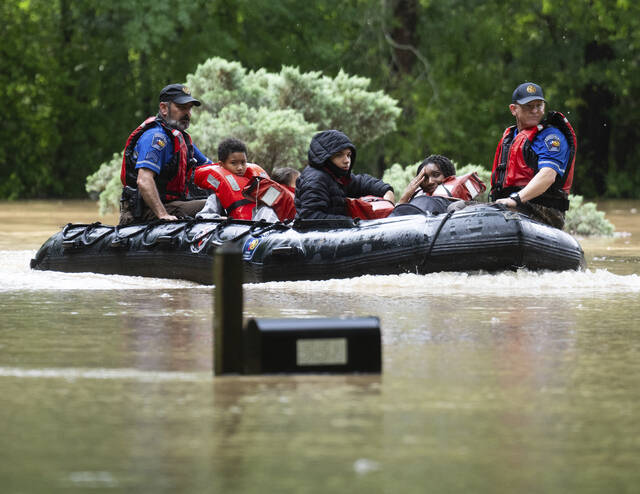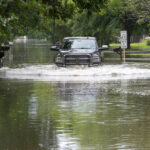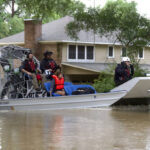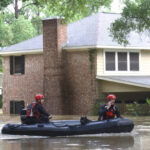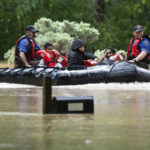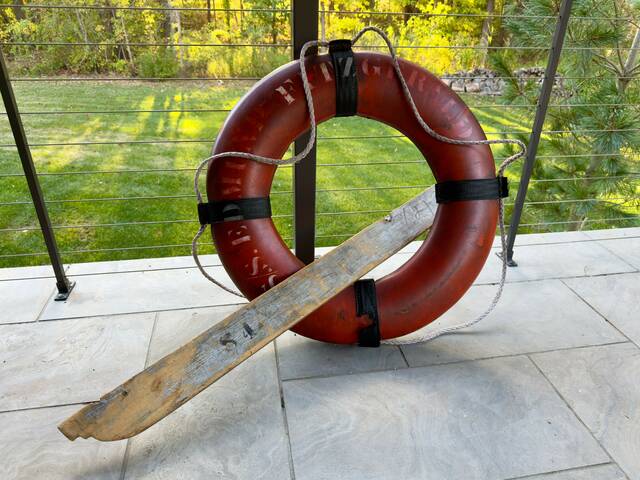HOUSTON — The Houston area was under threat of worsening flood conditions Saturday, a day after heavy storms slammed the region and authorities warned those in low-lying areas to evacuate ahead of an expected “catastrophic” surge of water.
A flood watch remained in effect through Sunday afternoon as forecasters predicted additional rainfall Saturday night, bringing another 1 to 3 inches (2.5 to 7.6 centimeters) of water to the soaked region and the likelihood of major flooding.
Friday’s storms forced numerous high-water rescues, including some from the rooftops of flooded homes. Officials redoubled urgent instructions for residents in low-lying areas to evacuate, warning the worst was still to come.
“This threat is ongoing and it’s going to get worse. It is not your typical river flood,” said Harris County Judge Lina Hidalgo, the top elected official in the nation’s third-largest county.
She described the predicted surge of water as “catastrophic” and said several hundred structures were at risk of flooding. There had already been at least two dozen water rescues in the county, in addition to getting 30 pets to safety. Schools in the path of the flooding canceled classes and roads jammed as authorities closed highways taking on water.
For weeks, drenching rains in Texas and parts of Louisiana have filled reservoirs and saturated the ground. Floodwaters partially submerged cars and roads this week across parts of southeastern Texas, north of Houston, where high waters reached the roofs of some homes.
More than 11 inches (28 centimeters) of rain fell during a 24 hour period that ended Friday morning in the northern Houston suburb of Spring, according to the National Weather Service.
In the rural community of Shepherd, Gilroy Fernandes said he and his spouse had about an hour to evacuate after a mandatory order. Their home is on stilts near the Trinity River, and they felt relief when the water began to recede on Thursday.
Then the danger grew while they slept.
“Next thing you know, overnight they started releasing more water from the dam at Livingston. And so that caused the level of the river to shoot up by almost 5 or 6 feet overnight,” Fernandes said. Neighbors who left an hour later got stuck in traffic because of flooding.
In Montgomery County, Judge Mark Keough said there had been more high-water rescues than he was able to count.
“We estimate we’ve had a couple hundred rescues from homes, from houses, from vehicles,” Keough said.
In Polk County, located about 100 miles (160 kilometers) northeast of Houston, officials have done over 100 water rescues in the past few days, said Polk County Emergency Management Coordinator Courtney Comstock.
She said homes below Lake Livingston Dam and along the Trinity River have flooded.
“It’ll be when things subside before we can do our damage assessment,” Comstock said.
Authorities in Houston had not reported any deaths or injuries. The city of more than 2 million people is one of the most flood-prone metro areas in the country and has long experience dealing with devastating weather.
Hurricane Harvey in 2017 dumped historic rainfall on the area, flooding thousands of homes and resulting in more than 60,000 rescues by government rescue personnel across Harris County.
Of particular concern was an area along the San Jacinto River in the northeastern part of Harris County, which was expected to continue rising as more rain falls and officials release extra water from an already full reservoir. Judge Hidalgo on Thursday issued a mandatory evacuation order for those living along portions of the river.
Most of Houston’s city limits were not heavily impacted by the weather, except for the northeastern neighborhood of Kingwood. Officials said the area had about four months of rain in about a week’s time. Houston Mayor John Whitmire said rising flood waters from the San Jacinto River were expected to impact Kingwood late Friday and Saturday.
Shelters have opened across the region, including nine by the American Red Cross.
The weather service reported the river was above 69 feet (21 meters) around noon Friday and expected to crest at 78 feet (23.7 meters) Friday night. The river is expected to fall below flood stage of 58 feet (17.6 meters) Tuesday afternoon, according to the weather service.
The greater Houston area covers about 10,000 square miles — a footprint slightly bigger than New Jersey. It is crisscrossed by about 1,700 miles (2,736 kilometers) of channels, creeks and bayous that drain into the Gulf of Mexico, about 50 miles (about 80 kilometers) to the southeast from downtown.
The city’s system of bayous and reservoirs was built to drain heavy rains. But engineering initially designed nearly 100 years ago has struggled to keep up with the city’s growth and bigger storms.



